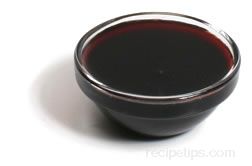To remove the seeds cleanly, cut the pomegranate in half and push the inedible membrane inside out allowing the seeds to remain together. Another method is to place the fruit into a bowl of water. Holding the fruit under water, cut off the end opposite the stem and then lightly score four even sections of the sides from stem to the other end. After scoring, pull the fruit apart to remove the inner arils from the skin holding it together. As the fruit is removed in the water, the seeds fall to the bottom of the bowl and the pith comes to the surface. Discard the pith, strain the water from the seeds, let dry and place the seeds in an airtight plastic bag or container. The seeds can then be refrigerated for weeks and if frozen, can be kept for 3 to 4 months. The seeds can be squeezed to produce pomegranate juice or be used as a garnish for salads, meats and desserts, providing a tart flavor and a crunchy texture.
Pomegranate juice is available in stores or can be produced from the fruit. To make the juice, prepare the fruit by rolling it on a hard surface to weaken the seed sacks within the fruit. Cut the fruit into two halves being careful to retain the contents and juice as much as possible. Place the contents into a strainer and apply pressure on the pulp to extract the juice and when finished, throw away the pulp. A blender or a food processor can also be used to crush the fruit and prepare it for straining. 1 cup of juice can be squeezed from approximately 6 pomegranates.
Pomegranates are also used to make a type of molasses, originating from the Middle East and now available throughout the world. It provides a sharp flavor when added as an ingredient to food dishes. To make 1/2 cup of molasses from pomegranates, lightly heat 4 cups of juice in a pan for 45 minutes or so, allowing it to thicken but not overcook, which produces a dark sap-like mixture instead of a smooth slow flowing molasses. Pomegranate molasses can be stored in an airtight container, refrigerated for 3 months or so.
When selecting this fruit, look for larger pomegranates, containing more juice, with a soft, somewhat pliable skin that is nicely colored and relatively free of blemishes. A pomegranate will store in a refrigerator for up to 3 months.












